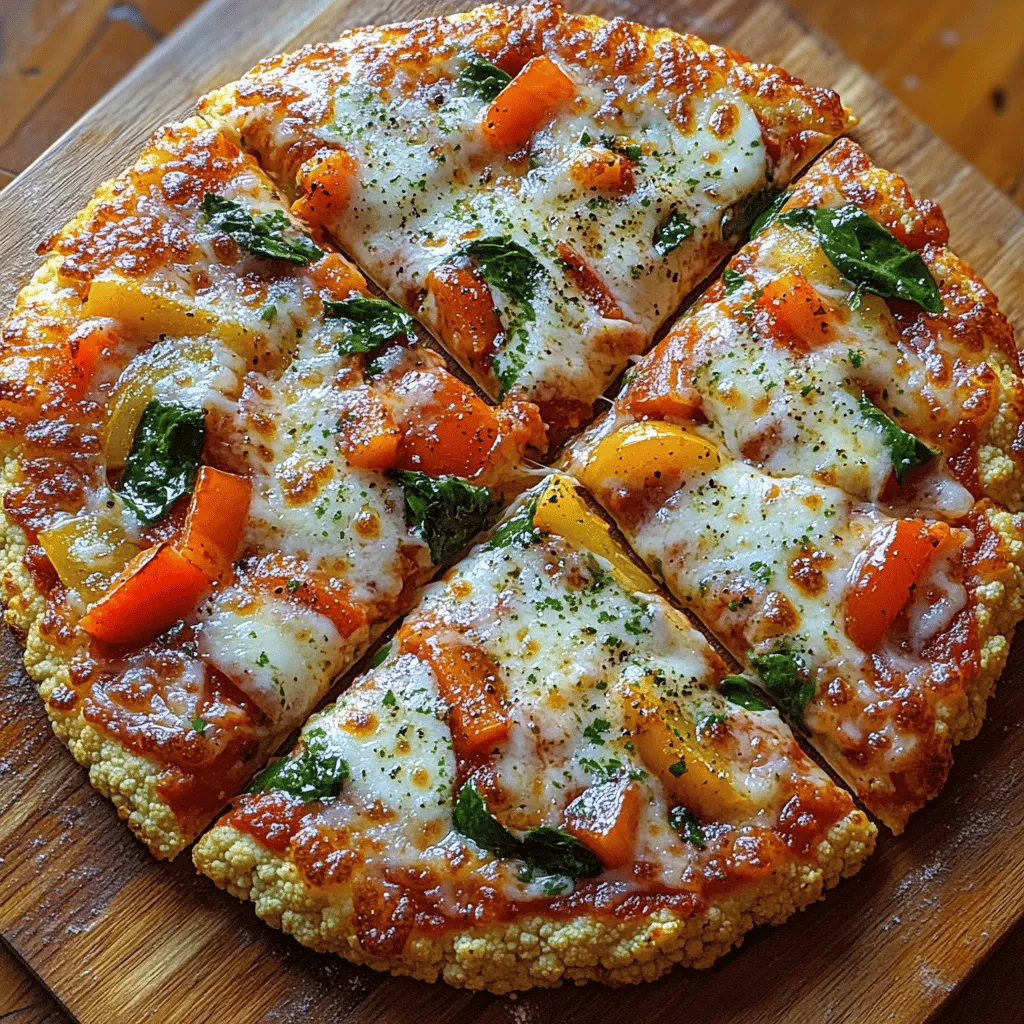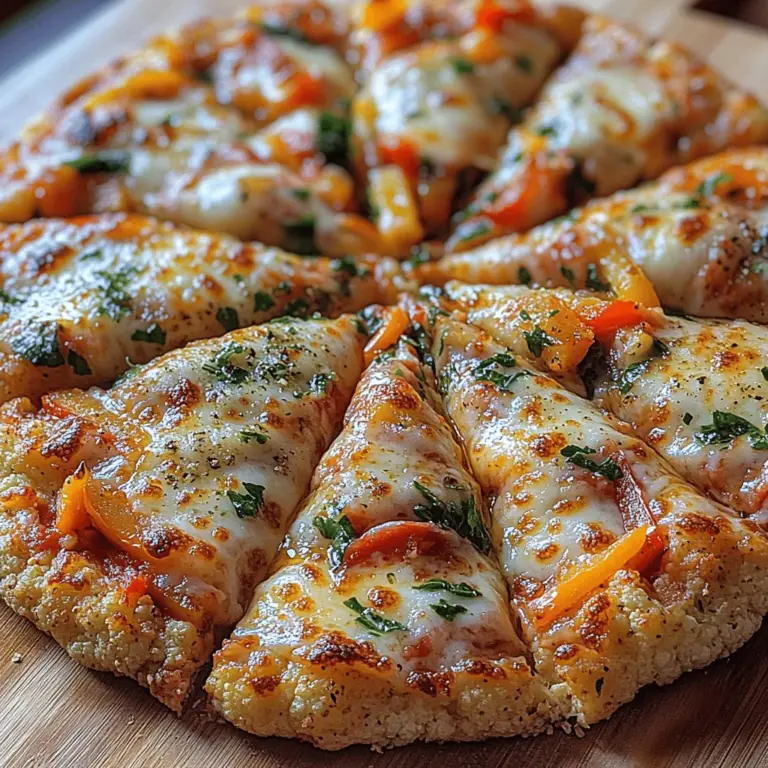Introduction
In the culinary world, pizza is often hailed as a universal comfort food. Its ability to bring people together makes it a favorite across various cultures and cuisines. However, the traditional pizza, with its rich dough and heavy toppings, can sometimes be a guilty pleasure rather than a wholesome meal. Enter the Cauliflower Pizza Crust, a revolutionary dish that swaps out conventional flour for nutrient-packed cauliflower, providing a guilt-free alternative without compromising on flavor or satisfaction. This recipe not only caters to those seeking healthier eating options but also appeals to gluten-free dieters and vegetable lovers alike.
The journey of creating a cauliflower pizza crust began in the quest for balance—a way to enjoy pizza without the heavy carbs. For many, including myself, pizza nights were synonymous with indulgence, often leading to post-meal regret. The introduction of cauliflower into the pizza scene changed the game, allowing for a delicious and nutritious meal that aligns with modern dietary preferences. This recipe has become a staple in my kitchen, often bringing friends and family together for fun, interactive cooking nights.
As we dive into this recipe, we will explore its significance in the context of healthy eating and the versatility it offers. From the ingredients to the preparation techniques, let’s embark on the journey to create a delightful cauliflower pizza crust that will impress even the most skeptical pizza lovers.
Understanding the Basics of the Recipe
Ingredients Overview
The foundation of any great recipe lies in its ingredients. For the Guilt-Free Cauliflower Pizza Crust, the primary ingredient is—unsurprisingly—cauliflower. This versatile vegetable is not only low in calories but also rich in vitamins C and K, fiber, and antioxidants. Here’s a quick look at the essential ingredients that come together to create this delightful pizza crust:
– Cauliflower: The star of the dish, providing structure and a mild flavor.
– Cheese: A blend of mozzarella and parmesan adds richness and binds the crust. For a dairy-free version, nutritional yeast can be used for a cheesy flavor.
– Egg: Acts as a binding agent to hold the crust together. For a vegan option, flaxseed meal mixed with water can serve as a substitute.
– Seasonings: Italian herbs like oregano and basil, along with garlic powder and onion powder, enhance the flavor profile of the crust.
– Salt and Pepper: Essential for seasoning, helping to elevate the overall taste.
Fresh Produce and Their Importance
Incorporating fresh produce into your meals is vital for overall health and nutrition. With the cauliflower forming the base, consider adding other fresh vegetables as toppings. Bell peppers, spinach, mushrooms, and onions are excellent choices that not only provide additional nutrients but also add flavor and texture. Using fresh ingredients guarantees a vibrant and colorful pizza that is as visually appealing as it is delicious.
Key Spices and Seasonings
The right spices and seasonings can transform a basic dish into something extraordinary. For this cauliflower crust, the following spices play a crucial role:
– Italian Seasoning: A blend of herbs that brings that classic pizza flavor.
– Garlic Powder: Adds depth and a savory note that complements the cheese.
– Crushed Red Pepper Flakes: For those who enjoy a kick, these can be sprinkled into the dough or as a topping.
Protein Options and Variations
While the cauliflower crust is a fantastic base for vegetarian pizzas, it can also accommodate various protein options for those looking to add more substance. Consider topping your pizza with grilled chicken, turkey sausage, or even plant-based proteins like chickpeas or lentils. The flexibility of this recipe allows you to customize it according to dietary preferences, making it suitable for both meat lovers and vegetarians alike.
Equipment and Tools Required
To create the perfect cauliflower pizza crust, having the right equipment is essential. Here’s a list of tools that will make your cooking experience smooth and enjoyable:
– Food Processor: To easily rice the cauliflower into fine bits.
– Baking Sheet: A standard size will work, or opt for a pizza stone for a crispier crust.
– Mixing Bowls: For combining the ingredients.
– Parchment Paper: To line the baking sheet, preventing sticking and making cleanup easier.
– Measuring Cups and Spoons: For accurate ingredient measurements.
Essential Kitchen Tools
In addition to the basic equipment, consider these handy tools:
– Grater: If you prefer freshly grated cheese over pre-shredded for better melting quality.
– Spatula: For spreading the cauliflower mixture evenly on the baking sheet.
– Whisk: If you’re using eggs, a whisk can help beat them evenly.
Step-by-Step Preparation Process
Preparing the Ingredients
The first step in creating your Guilt-Free Cauliflower Pizza Crust is to prepare your ingredients. This involves ricing the cauliflower, which is crucial for achieving the right texture.
1. Ricing the Cauliflower: Start by washing a medium head of cauliflower thoroughly. Remove the leaves and stem, then cut it into florets. Place the florets in a food processor and pulse until they resemble rice or couscous. This process should take about 30 seconds to 1 minute.
2. Steaming the Cauliflower: Once riced, the cauliflower needs to be steamed to soften it. You can do this by placing it in a microwave-safe bowl with a splash of water, covering it with a lid or plastic wrap, and microwaving for about 4-5 minutes. Alternatively, you can steam it on the stove for a few minutes until tender.
3. Draining Excess Moisture: After steaming, it’s crucial to remove as much moisture as possible from the cauliflower. Transfer the riced cauliflower to a clean kitchen towel or cheesecloth, and twist it tightly to squeeze out the water. This step ensures a crispy crust instead of a soggy one.
Washing and Chopping Vegetables
If you plan to add fresh vegetables as toppings, take this opportunity to wash and chop them. Choose a variety of colors for a visually appealing dish. Some great choices include:
– Bell Peppers: Slice them thinly for even cooking.
– Spinach: Roughly chop or leave whole for added nutrition.
– Mushrooms: Clean and slice them for a savory topping.
Marinating Proteins (If Applicable)
If you’re adding proteins to your pizza, consider marinating them for enhanced flavor. For instance, if you’re using chicken, a quick marinade of olive oil, garlic, lemon juice, and herbs can add a delightful taste. Allow the protein to marinate for at least 15-30 minutes to absorb the flavors.
Cooking Techniques
There are several methods to ensure your cauliflower pizza crust turns out perfectly. The key is to manage cooking times and temperatures effectively.
1. Baking the Crust: Preheat your oven to 425°F (220°C). While the oven heats up, mix the riced cauliflower with cheese, egg, and seasonings in a mixing bowl. Spread the mixture onto a lined baking sheet, shaping it into a round or rectangular crust about 1/4-inch thick. Bake for approximately 25-30 minutes or until the edges turn golden brown.
2. Sautéing or Boiling Toppings: For toppings like mushrooms or bell peppers, consider sautéing them in a pan with a bit of olive oil and seasoning to bring out their flavors. This step enhances the overall taste and texture of the pizza.
Importance of Cooking Times and Temperatures
The success of your pizza crust heavily relies on cooking times and temperatures. Baking at the right temperature ensures that your crust becomes crispy and holds together well. Keep an eye on it as it bakes to avoid overcooking or burning.
Assembly of the Dish
Once the crust is baked, it’s time to assemble your pizza.
1. Layering Ingredients for Optimal Flavor: Start by spreading a thin layer of pizza sauce over the crust. Follow it up with a generous sprinkle of cheese, then layer with your choice of toppings. Be mindful not to overload the crust, as this can make it soggy.
2. Presentation Tips for a Visually Appealing Dish: For a stunning presentation, consider adding fresh herbs like basil or arugula after baking. A drizzle of balsamic glaze can also elevate the look and flavor of your pizza.
By following these steps, you’ll create a delicious Guilt-Free Cauliflower Pizza Crust that is not only healthy but also a crowd-pleaser. Stay tuned for the next part of this article where we explore the various flavor profiles and creative variations you can incorporate to make this dish your own.

Innovations and Contemporary Twists
The Guilt-Free Cauliflower Pizza Crust Delight is not only a healthier alternative to traditional pizza crusts but also a versatile canvas for culinary creativity. Home cooks and chefs alike are embracing contemporary twists on this classic dish, making it a staple in many kitchens. For instance, you can enhance the flavor profile by incorporating various herbs and spices into the cauliflower mixture. Adding garlic powder, onion powder, or even nutritional yeast can elevate the taste while keeping it guilt-free.
Another innovative approach is to experiment with different types of cheese. While mozzarella is the traditional choice, using goat cheese or a blend of vegan cheeses can create unique flavor combinations that cater to different dietary preferences. Additionally, consider integrating cooked vegetables directly into the crust mixture, like finely chopped spinach or roasted red peppers, for an extra nutritional boost and vibrant color.
Dietary Modifications
The beauty of the Cauliflower Pizza Crust lies in its adaptability for various dietary needs. For those adhering to a low-carb or ketogenic diet, this crust is a perfect fit, as it contains significantly fewer carbohydrates than traditional wheat-based crusts. You can enhance the nutritional profile by adding ground flaxseed or chia seeds, which are high in omega-3 fatty acids and fiber.
For those with specific dietary restrictions, it’s crucial to be mindful of the ingredients you incorporate. If you’re looking to reduce dairy intake, opt for plant-based cheese alternatives or nutritional yeast for a cheesy flavor without the calories.
Vegetarian or Vegan Adaptations
This recipe is inherently friendly for vegetarians, but with a few simple adjustments, it can easily be made vegan. Opt for a flaxseed or chia seed egg substitute: mix one tablespoon of ground flaxseed or chia seeds with three tablespoons of water and let it sit for a few minutes until it thickens. This natural binder works beautifully in the crust, ensuring it holds together well without the need for eggs.
When it comes to toppings, the possibilities are endless! Load your pizza with an assortment of fresh vegetables like mushrooms, bell peppers, and zucchini. You can also try vegan sausage, tempeh, or chickpeas for added protein, providing a hearty and satisfying meal.
Gluten-Free and Other Allergen-Friendly Options
The Guilt-Free Cauliflower Pizza Crust is naturally gluten-free, making it an excellent choice for those with gluten sensitivities or celiac disease. However, always check the labels on any additional ingredients, such as cheese or sauces, to ensure they are also gluten-free.
For nut-free options, be cautious with any toppings or cheese alternatives that may contain nuts. Instead, focus on seeds or legumes for protein, such as sunflower seeds or lentils. This way, you can maintain a nutritious and allergen-friendly dish without compromising on flavor.
Pairing Suggestions
Complementary Side Dishes
To create a well-rounded meal, consider pairing your Cauliflower Pizza with complementary side dishes. A light and refreshing arugula salad dressed with lemon vinaigrette provides a crisp contrast to the warm, cheesy pizza. Alternatively, roasted or sautéed vegetables can enhance the meal’s nutritional value while adding an appealing visual element.
Salads, Breads, or Grains That Enhance the Meal
Incorporate a side of quinoa or farro salad with diced cucumbers, cherry tomatoes, and a drizzle of balsamic glaze for a hearty addition that harmonizes beautifully with the flavors of the pizza. If you want to keep it light, a simple mixed greens salad with a tangy dressing will suffice.
Beverage Pairings
When it comes to beverages, the right pairing can elevate your dining experience. A crisp white wine, such as Sauvignon Blanc or Pinot Grigio, complements the fresh flavors of the pizza. If you prefer cocktails, a refreshing mojito or a light gin and tonic can provide a delightful contrast. For a non-alcoholic option, consider sparkling water with a splash of fresh citrus for a refreshing palate cleanser.
Nutritional Value and Health Benefits
Breakdown of Key Nutrients
Cauliflower is a nutrient-dense vegetable, rich in vitamins C and K, fiber, and antioxidants. A single serving of the cauliflower pizza crust contains significantly fewer calories and carbohydrates compared to traditional pizza crusts. Typically, one slice of this pizza may have around 100 calories, depending on the toppings used, while a traditional slice often exceeds 200 calories.
Health Benefits Associated with the Main Ingredients
The primary ingredient, cauliflower, is low in calories and high in fiber, making it a great choice for weight management. Furthermore, its high antioxidant content can help reduce inflammation and lower the risk of chronic diseases. Adding various vegetables as toppings not only enhances the flavor but also increases the nutritional density of your meal.
Caloric Considerations and Serving Sizes
When enjoying your Cauliflower Pizza, be mindful of portion sizes. A single serving can be one to two slices, depending on your hunger level and the toppings used. Balancing your pizza with a side salad or vegetable dish can help you feel satisfied without overindulging.
Cultural Significance and History
Origins of the Dish
While pizza itself has a rich history rooted in Italian cuisine, the concept of using cauliflower as a crust is a more recent innovation, gaining popularity in the health-conscious communities of the early 21st century. This adaptation reflects the growing trend of seeking healthier alternatives to traditional comfort foods.
Regional Variations and Their Unique Characteristics
Different regions have embraced the cauliflower crust in various ways. For instance, some cooks might add Italian herbs to the crust to pay homage to its roots, while others may incorporate spices typical of Middle Eastern cuisine, such as cumin or za’atar, for a unique twist. Each variation showcases the crust’s adaptability and global appeal.
How the Recipe Has Evolved Over Time
As dietary preferences evolve, so too has the cauliflower pizza crust recipe. Initially celebrated as a low-carb option, it has transformed into a gluten-free, vegetarian, and even vegan staple, appealing to a variety of dietary needs. This evolution shows how traditional recipes can adapt and thrive in modern cooking.
Storing and Reheating the Dish
Best Practices for Storage
To store leftover Cauliflower Pizza, allow it to cool completely before placing it in an airtight container. This will help maintain its texture and prevent moisture build-up. The pizza can be stored in the refrigerator for up to three days.
Tips for Reheating Without Losing Flavor or Texture
When it comes to reheating, the oven is your best bet for keeping the crust crispy. Preheat your oven to 350°F (175°C) and place the pizza directly on the oven rack or on a baking sheet for about 10-15 minutes until heated through. This method preserves the crust’s texture better than microwaving, which can lead to a soggy pizza.
Freezing Guidelines for Meal Prep
If you want to prepare your Cauliflower Pizza Crust in advance, consider freezing it before adding toppings. Roll out the crust, bake it until firm, and let it cool. Then, wrap it tightly in plastic wrap and store it in a freezer-safe bag for up to three months. When you’re ready to enjoy it, simply thaw it in the refrigerator, add your favorite toppings, and bake.
Conclusion
The Guilt-Free Cauliflower Pizza Crust Delight is a versatile and nutritious option that caters to a wide range of dietary preferences. Its adaptability allows for countless variations, encouraging creativity in the kitchen. Whether you choose to load it with fresh vegetables, experiment with different cheeses, or enjoy it alongside a crisp salad, this recipe is sure to satisfy cravings while promoting healthier eating habits.
As you explore the various adaptations and pairings, remember that cooking is not just about the final dish—it’s also about the joy of experimenting, sharing meals with loved ones, and creating lasting memories around the table. So, roll up your sleeves, embrace your culinary creativity, and enjoy the delightful experience of making and sharing your guilt-free cauliflower pizza!

